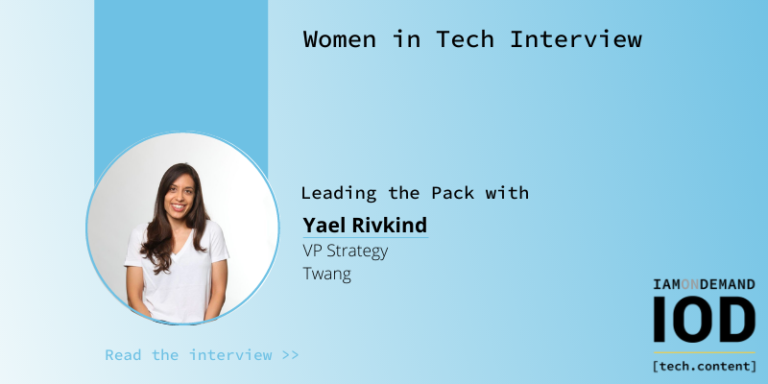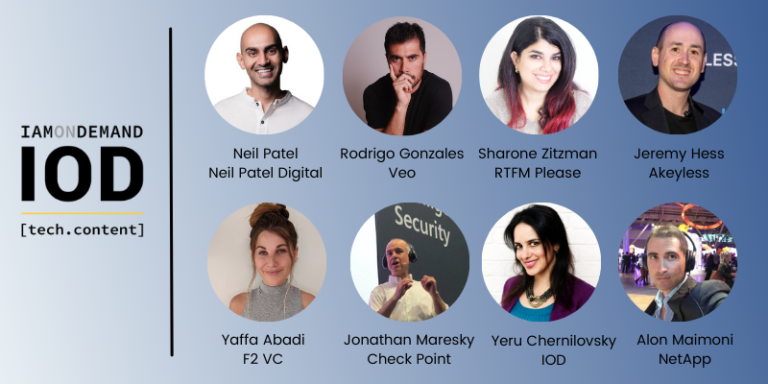Welcome to the second post in our series celebrating female leaders in technology companies. When we thought about writing a post in honor of International Women’s Day on March 8th, we realized there was no way we could do justice to every single woman we know who’s leading the way in tech. That’s why we decided to take a whole month to do it right with this series of seven posts profiling some of these amazing women.
Harvard Business Review reports that female leaders can be great strategic thinkers and are “more likely to coach, mentor, and develop their direct reports.” However, there are often major barriers in their way, including the challenges of achieving just the right work-life balance, bringing passion, dedication, and energy to parenthood and the workplace equally. Traditionally, this burden has been placed more on women’s shoulders than on men’s, but some of the leaders we’re profiling in this series are helping to change that.
In our first post, we interviewed Yael Rivkind, VP of Strategy at Twang, who talked about her influence on the startup companies she’s been a part of. There, we mentioned that only 20% of computer science grads are women.
Today’s guest is an exception. After earning a B.Sc. in Computer Science, Michal Wosk went on to work in software development for Microsoft and Intel. She later earned an MBA before landing at her current role as Marketing VP at Treeverse, a global company that offers a lot of flexibility to parents on staff.
TREEVERSE QUICK STATS
Founded: 2020
HQ: Tel Aviv
Site: https://treeverse.io/
Are there any meaningful events in your backstory that helped shape your career path?
As a dramatic person, my career story is rich with dramatic and meaningful events, which I am sure led me to where I am right now. An exceptional event that helped me understand what my superpower at work is was in 2014, when I went to the Intel headquarters in Santa Clara, days before the app I was the product manager of was to be presented by Intel’s then-CEO.
I had to demo the app and the device it was running on, which were only assembled a few days earlier, and train the CEO, who was supposed to present it on the stage of CES in Las Vegas—the biggest consumer electronics summit in the world. The whole team of engineers who built this product were relying on me to operate the entire thing and make sure that everything was working on stage. Any tiny mistake, and the entire demo would be a failure—and not a regular failure: one that the whole world would see.
When I saw the looks in my team’s eyes—how much was depending on me in that moment and how many people I would disappoint if I failed—I decided that the only way to succeed was to be as confident as I could and spread this confidence to my team: Yes, we can do it. Later on, they told me that my confidence and calm energy enabled them to deliver the demo successfully and without unnecessary stress. I then understood that wherever I go, the confidence and power I give to other people is my superpower, and I’ve used it at work ever since.
Which aspects of your job do you like most?
I love so many things about my job. I love how everything I do is connected to the company’s business and the financial bottom line. I love that it combines my two passions: technology and people. As a marketer, my main job is to tell the story of the product and the company in a way that will generate interest and demand with customers. I love the variety and richness of the objectives I need to achieve, and the outcome of this: the fact that no day is similar to the day before it, which makes my life so interesting.
But the best part of my job, the part that I think to myself, “S$#T, I can’t believe I’m getting paid for this,” is the fact that I work with so many different people. Whether they are co-workers, customers, community members, influencers, vendors, consultants, or investors, I learn so much from them. And, most of the time, they become my friends, even when we stop working together. I always say that I am wearing a metaphoric diamond necklace, and the diamonds are the friends I take with me throughout my career path.
Can you share some demographics about women at Treeverse (and possibly at former companies like Microsoft)? In what areas/positions would you like to see more women leaders?
At Treeverse, we are not talking about diversity and inclusion—we are actively doing it. Our management is 60% female, and the entire company is 40% female. Our CEO is a woman, which is still very uncommon in the ecosystem. We are a global company by design, which also means that we can work from whatever location and time zone we please.
As a mother, this is a great advantage. The time I save on commuting to work is spent with my family, and the flexibility my work gives me enables me to invest time and energy in other activities that are important to me, like learning, yoga, and volunteering. I truly believe that being able to do that makes me a better employee and manager—more calm, creative, and compassionate.
What challenges do you think women in tech are facing today? What challenges have you experienced?
I grew up in the tech industry and feel that I’ve experienced the entire transition—from being a minority in school (I studied computer science) and work, to the state that we are in today. In the first job I held after becoming a mother, I received a bad yearly review from my manager because I wasn’t able to invest as much time at work as my male colleagues. There was little to no compassion toward the challenge of being a mother for the first time and combining it with my career. Back then, not all managers could see the value of diversifying their workforce and enabling more women to join their teams.
Luckily, the times are changing, and I am happy to see that less and less women need to choose between a career and motherhood. But, moreover, I see that employers understand that a diverse team is mandatory for the success of the business and are actively and intentionally working towards diversifying their teams. 50% women in every company, school, and management team is still a goal, but I think that the young generation of women taking over the tech industry is definitely on the way there.
How would you define and quantify success for women in tech in 10 years?
In 10 years, I am hoping to see women take 50% of all positions—similar to our percentage in society—both in leadership and practitioner roles. For that, much more needs to be done in the tech industry. I know that bullying women, making them feel uncomfortable, objectifying them, and discriminating against them still exists. This should be treated in any organization with zero tolerance. I trust the young generation of women we are raising to continue this revolution until we are equally represented, treated, and paid.
ICYMI: Our Latest Posts

Women in Tech Interview: Leading the Pack with Yael Rivkind, VP of Strategy at Twang
Here at IOD, we love all the tech leaders we’ve met over the years—at AWS re:Invent, other industry gatherings, and online. But we’re honestly troubled

Marketing Experts Predict: Tech Marketing Trends in 2022
Years ago, Apple ran TV ads for the newly launched iPhone, featuring the line, “There’s an app for that.” It was impossible to predict just

Don’t Have a DevOps Team? This Is Why You’re Wrong
If you’re not sure what “DevOps” means, and whether or not you need a DevOps team in your organization, this article is for you. Here,
Final question: Can you offer one tip for women who aspire to work in leadership positions?
My biggest tip for any aspiring leader is to be very very kind. It is not a cliché that eventually, you will not be remembered by your actions, but by how you made others feel. Being kind doesn’t mean not having an opinion of your own or that you have to agree with everybody. But, still, you can be the smartest person in the room and still be very kind. Try to end all the interactions you are part of with a win-win outcome—and remember that what goes around always comes around, so it’d better be something good!
Summary
Michal says that “luckily” times are changing for moms in the workforce, but the truth is, they’re probably changing because of women like her—women who demonstrate that tech excellence and leadership are absolutely compatible with parenthood. With women like Michal driving the change, her goal of achieving a 50% female workforce within 10 years seems completely within reach.
Stay tuned for our next profile, in which Karin Wolok, Head of Developer Marketing and Community at StarTree, reveals how she got her start in technology in a rather “entertaining” and unconventional way.

